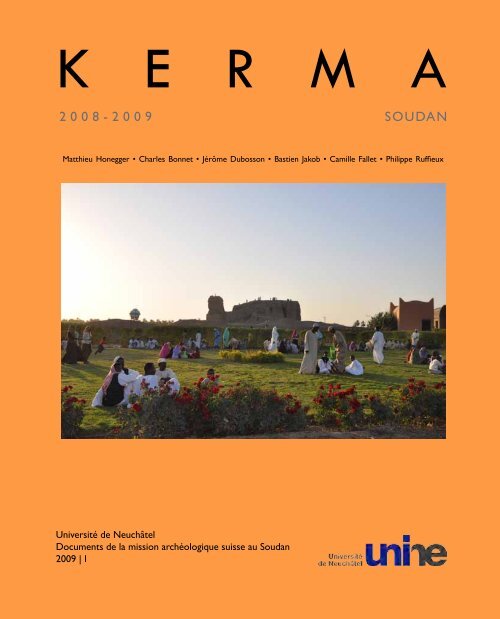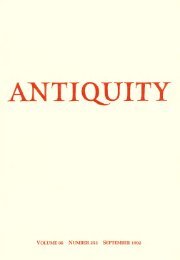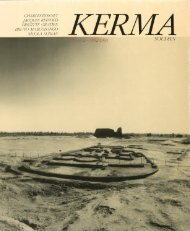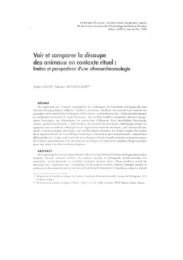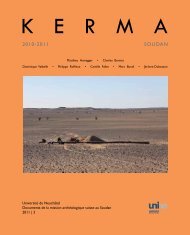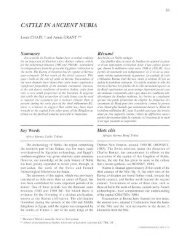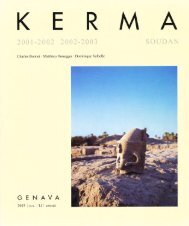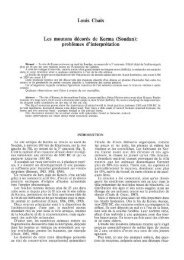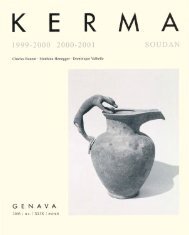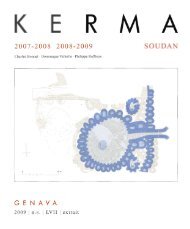Archaeological excavations at Kerma
Archaeological excavations at Kerma
Archaeological excavations at Kerma
Create successful ePaper yourself
Turn your PDF publications into a flip-book with our unique Google optimized e-Paper software.
K E R M A2 0 0 8 - 2 0 0 9 SOUDANM<strong>at</strong>thieu Honegger • Charles Bonnet • Jérôme Dubosson • Bastien Jakob • Camille Fallet • Philippe RuffieuxUniversité de NeuchâtelDocuments de la mission archéologique suisse au Soudan2009 | I
I M P R E S S U MUniversité de NeuchâtelDocuments de la mission archéologique suisse au Soudan2009 | IInstitut de Préhistoire et des Sciences de l’AntiquitéEspace Paul VougaCH-2068 HauteriveSwitzerlandScientific Committee : M<strong>at</strong>thieu Honegger, Charles Bonnet, Louis Chaix, NoraFerrero.Transl<strong>at</strong>ion : Caroline M. RocheleauLayout : Philippe MartiHonegger, M., Bonnet, C. & Collab. 2009. « <strong>Archaeological</strong> <strong>excav<strong>at</strong>ions</strong> <strong>at</strong> <strong>Kerma</strong>(Sudan) », Documents de la mission archéologique suisse au Soudan (1), Université deNeuchâtel.© 2009 Institut de Préhistoire et des Sciences de l’Antiquité, Université de NeuchâtelISSN : 1663-2664
M<strong>at</strong>thieu Honegger andCharles BonnetARCHAEologICAL exCAVAtions <strong>at</strong> KERMA (SUDAN) • PRELIMINARyreport to the 2008-2009 SEASonThe investig<strong>at</strong>ions of the Swiss <strong>Archaeological</strong> Mission started on November 30,2008 and were completed on February 2, 2009.The team directed by M<strong>at</strong>thieu Honegger conducted <strong>excav<strong>at</strong>ions</strong> <strong>at</strong> the easterncemetery of <strong>Kerma</strong> and <strong>at</strong> the site of Wadi El-Arab, and also worked <strong>at</strong> the <strong>Kerma</strong>Museum. The team comprised the rais Khidir Magbul and Jaffar Abdul Fares, whoguided 30 local workers, and three specialists from Switzerland who worked intheir respective field : Louis Chaix (anthropology and archaeozoology), MarionBerti (archaeology and drawing) and Daniel Conforti (archaeology and drawing).Four students from the University of Neuchâtel (Jérôme Dubosson, Bastien Jakob,Camille Fallet, and Laure Bassin) and a student from the University of Khartoum(Shahinda Omer) also particip<strong>at</strong>ed in the season’s work.The team led by Charles Bonnet, which worked <strong>at</strong> Dukki Gel and the ancient city of<strong>Kerma</strong>, was composed of the rais Gad Abdallah, Saleh Melieh, Abdelrazek OmerNuri and Idriss Osman Idriss, who guided 60 local workers. It included fivespecialists from Switzerland : Philippe Ruffieux (ceramic studies), Inès M<strong>at</strong>ter-Horisberger (drawing), Alain Peillex (drawing), Marc Bundi (technician, drawing),and Louis Chaix (archaeozoology).Mr. Abdelhai Abdelsawi, inspector and cur<strong>at</strong>or of the <strong>Kerma</strong> Museum, monitoredthe progress of fieldwork and supervised the prepar<strong>at</strong>ions for the Museum’s secondinaugur<strong>at</strong>ion.The Swiss Mission was supported by Mr. Hassan Hussein, director of the N<strong>at</strong>ionalCorpor<strong>at</strong>ion of Antiquities and Museums of Sudan (NCAM) and his collabor<strong>at</strong>ors,Drs Salah Eddin Mohamed Ahmed and Abdelrahman Ali. Following the install<strong>at</strong>ionof three scale models representing the ancient towns of <strong>Kerma</strong> and Pre-<strong>Kerma</strong>, and the hut of El-Barga, a second inaugur<strong>at</strong>ion of the <strong>Kerma</strong> Museum washeld on January 10, 2009. The event was <strong>at</strong>tended by a Swiss deleg<strong>at</strong>ion of eightindividuals representing political, scientific and academic institutions, the directorand collabor<strong>at</strong>ors of NCAM, the president of the High Committee of the <strong>Kerma</strong>Cultural Complex (Sir El H<strong>at</strong>im), several ministers, and the wali of Dongola.This project is financed by the Swiss N<strong>at</strong>ional Science Found<strong>at</strong>ion (projectn°101212-122592/1), by the St<strong>at</strong>e Secretari<strong>at</strong> for Educ<strong>at</strong>ion and Research of theSwiss Confeder<strong>at</strong>ion and by priv<strong>at</strong>e funds.1
The investig<strong>at</strong>ions focused on the <strong>excav<strong>at</strong>ions</strong> of :• a new sector in Wadi el-Arab;• a new sector of the Pre-<strong>Kerma</strong> settlement;• Ancient <strong>Kerma</strong> graves in the northern part of the eastern cemetery;• fortific<strong>at</strong>ions and temples in Dukki-Gel.This season, restor<strong>at</strong>ion and preserv<strong>at</strong>ion work was conducted <strong>at</strong> the main archaeologicalsites :• restor<strong>at</strong>ion of the stairs of the western Deffufa;• building of galus walls and embankments to protect the eastern cemetery fromdestruction caused by car and lorry traffic and the expansion of cultiv<strong>at</strong>ed fields.Figure 1 | Map of the <strong>Kerma</strong>area with the loc<strong>at</strong>ion of themain archaeological sites andthe Museum.2
M<strong>at</strong>thieu Honegger andBastien JakobThe EARLy HoloCENE seqUENCE of Wadi el-ArabThis site is loc<strong>at</strong>ed 5 km north-east of El-Barga and includes a str<strong>at</strong>igraphicsequence of occup<strong>at</strong>ions d<strong>at</strong>ed between 8,500 and 6,000 BC. It is one of the veryimportant sites of Africa th<strong>at</strong> helps understand the transition to a sedentary way oflife and stock breeding (Honegger 2007).This year, an area of 64 square meters was excav<strong>at</strong>ed where three graves were discoveredtwo years ago (sector 611W, see fig. 2 and 3). The aim was to preserve thispart of the site - which was plundered last year - in order to complete the chronologicalsequence and to find more graves. The destruction was more important thanany previous disturbances and impeded the <strong>excav<strong>at</strong>ions</strong> as work resumed in thissector. As previously noted <strong>at</strong> this site, the m<strong>at</strong>erial discovered consists primarilyof several lithic artefacts, fragments of ostrich eggshells and ceramic sherds. Faunalremains are less frequent. Some structures were identified : a pit of domesticfunction; a probable habit<strong>at</strong>ion structure dug in the sand; some pebbles’ concentr<strong>at</strong>ions(fig. 4). The pits contained gre<strong>at</strong>er quantities of artefacts and better preservedbones. One grave was discovered and we hope th<strong>at</strong> a cemetery will be loc<strong>at</strong>ed inthe future. Due to the abundance of m<strong>at</strong>erial and the precision required for theexcav<strong>at</strong>ion of Mesolithic sites, only fifteen centimeters were cleared in this area.The excav<strong>at</strong>ion of this sector will continue for the two next years.201918Wadi El-ArabWestern sectors1717516150 100 m165excav<strong>at</strong>ion2005-071413122321110923195876611W230excav<strong>at</strong>ion20055421W229432excav<strong>at</strong>ion2007excav<strong>at</strong>ion2007-092283101Figure 2 | Western sectorsof Wadi el-Arab with theloc<strong>at</strong>ion of trenches andexcav<strong>at</strong>ed surfaces.23 22 21 20 19 18 17 16 15 14 13 12 11 10 9 8 7 6 5 4 3 2 1 1 2 3 4 5 6 7 8 9 103
Figure 3 | View of the sector611 during <strong>excav<strong>at</strong>ions</strong>.Figure 4 | A concentr<strong>at</strong>ion ofpebbles which can correspondto the limit of a wall of thehabit<strong>at</strong>ion structure or to astructure linked to a fireplace.4
Figure 5 | The tomb 7 afterexcav<strong>at</strong>ion.First, the 64 square meters surfacewas cleaned and carefully cleared inorder to deline<strong>at</strong>e possible structuresand holes resulting from the pillageof the site. Then a second clearing offive to eight centimeters allowed us todefine the five structures identified.These are r<strong>at</strong>her well defined pits, generallycontaining a distinctive fill andoccasionally less fragmentary remains.While the anthropogenic n<strong>at</strong>ure ofseveral pits is undeniable, it is moreproblem<strong>at</strong>ic for three of them becausethey might have been affect by erosionand disturbances. The largest measuresapproxim<strong>at</strong>ely three meters in diameterand its depth is over twenty centimeters.The structure might be the floor of ahut, but further excav<strong>at</strong>ion is necessarybefore this can be confirmed.A tomb was discovered on the surface north of the sector, adding to the three foundpreviously (fig. 5). R<strong>at</strong>her disturbed by its proximity to the surface, the body of thedeceased is missing part of its cranium and most of the bones of the right side. Thedeceased rested in a flexed position on its left side, the head towards the west andfacing north. In contrast with one of the graves excav<strong>at</strong>ed in 2006, which revealed anecklace made of Red Sea shells, no burial goods were found in associ<strong>at</strong>ion with thistomb. These burials should be d<strong>at</strong>ed to between the 7 th and the beginning of the 6 thmillennium BC. The m<strong>at</strong>erial discovered during the <strong>excav<strong>at</strong>ions</strong> is abundant and thedensity of artefacts - notably flints and ceramics - is high. The two clearings brought tolight 6941 pieces carved from siliceous rock (the majority from the alluvial flint calledchert as well as a few pieces in carnelian and rock crystal).We note 249 nuclei and 3323 flakes,among which the rare blades. Ther<strong>at</strong>io of transform<strong>at</strong>ion into tools islow : only 374 pieces, the majority ofwhich are segments (fig. 6).Figure 6 | Proportion of thedifferent types of flint artefactsfound in sector 611.5
Figure 7 | Pottery discoveredin the first two clearings of thesector 611.A more in-depth study is needed to reveal possible influences th<strong>at</strong> might appear inthese lithic implements, but, <strong>at</strong> first glance, Egyptian influences are practically nonexistentand flint from the chalky limestone environments of the North does not appearto have been imported. There is one exception, however. Two bifacial points found onthe surface north of sector 611 might have an Egyptian origin considering their scarcityin Nubian prehistory. They might otherwise be fragments of spear points d<strong>at</strong>ed tothe <strong>Kerma</strong> period, such as the quartz ones found in the city of <strong>Kerma</strong> or the famousexamples from Mirgissa. They would thus be isol<strong>at</strong>ed finds linked to the Classic <strong>Kerma</strong>fort loc<strong>at</strong>ed nearby.The ceramic sherds are occasionally of large dimensions and often entirely coveredwith impressed motifs (fig. 7). These complete the series origin<strong>at</strong>ing from sectors65/75 and 95 currently under study, which indic<strong>at</strong>e an evolution between 7800 and6600 BC. The diversity of motifs is r<strong>at</strong>her similar to th<strong>at</strong> already known, with a fewnew variants. The assemblage clearly shows th<strong>at</strong> we are dealing with a sequencesitu<strong>at</strong>ed <strong>at</strong> the beginning of the 7 th millennium BC, represented with rocker stamp,dotted wavy line and herring bone p<strong>at</strong>tern (altern<strong>at</strong>ing pivoting stamp) decor<strong>at</strong>ions.It is possible th<strong>at</strong> future successive clearings will reveal previous occup<strong>at</strong>ions. In anycase, this chronological bracket is r<strong>at</strong>her interesting for the study of the transition toa pastoral economy with the appearance of domestic<strong>at</strong>ed c<strong>at</strong>tle (cf. Honegger 2005). Itshall also allow the evalu<strong>at</strong>ion of the impact of southern Egyptian influences (NabtaPlaya), which appear <strong>at</strong> this period. In this context, the meticulous g<strong>at</strong>hering of faunalremains is paramount and numerous bones were consolid<strong>at</strong>ed before sampling inorder to insure a better preserv<strong>at</strong>ion. Yet, this year, the first faunal inventory madeby Louis Chaix did not reveal domestic<strong>at</strong>ed c<strong>at</strong>tle, as had been the case in previousyears <strong>at</strong> Wadi el-Arab.6
M<strong>at</strong>thieu HoneggerThe Pre-KERMA aggloMERAtionIn the western sector of the Pre-<strong>Kerma</strong> settlement, an area of 1000 square meterswas studied in order to define the extension of the agglomer<strong>at</strong>ion and its complexity(fig. 8). Many postholes deline<strong>at</strong>ed fences and circular structures, and eight pits ofsmall diameter were discovered (fig. 9). Most are shallow, but one is 1.60 meterdeep and might correspond to a small well. The other pits contained much charcoaland many fireplaces were loc<strong>at</strong>ed. These were rel<strong>at</strong>ed to a craft activity involvingfire (ceramics firing, beer production, etc), but as of yet Pre-<strong>Kerma</strong> sherds havenot been discovered within these structures. These fe<strong>at</strong>ures and their apparentorganis<strong>at</strong>ion cannot be rel<strong>at</strong>ed to the Middle <strong>Kerma</strong> graves dug in this area, so theird<strong>at</strong>ing remains problem<strong>at</strong>ic. Therefore, C14 d<strong>at</strong>es will be needed to confirm the Pre-<strong>Kerma</strong> <strong>at</strong>tribution. Should these structures indeed d<strong>at</strong>e to the Pre-<strong>Kerma</strong>, then thisseason’s discoveries would confirm the considerable size of the settlement and thepossible existence of a specialised craft activity area.<strong>Kerma</strong> eastern cemeteryPre-<strong>Kerma</strong> SettlementPostholesMiddle <strong>Kerma</strong> gravesPitsReconstruction of hutsand fences20 mSector excav<strong>at</strong>ed in 2008-2009Neolithic occup<strong>at</strong>ionFigure 8 | Plan of the Pre-<strong>Kerma</strong> agglomer<strong>at</strong>ion withthe sector excav<strong>at</strong>ed duringthe campaign 2008-2009.7
Figure 9 | View of the sectorwith its pits and small circularstructure.8
M<strong>at</strong>thieu Honegger etJérôme DubossonAncient <strong>Kerma</strong> graves of the eastern cemetery266 W 262 W 254 W2541096 N2552563082581092 N277259260 2611088 N257262263 264267265 1084 N266268In order to understand the sp<strong>at</strong>ial organis<strong>at</strong>ion of the funerary ritual and to collectmore d<strong>at</strong>a on the origin of the <strong>Kerma</strong> civilis<strong>at</strong>ion, we continued the excav<strong>at</strong>ion ofsector CE27, which was partially studied by Charles Bonnet and Bé<strong>at</strong>rice Priv<strong>at</strong>iin 1998-1999 (Bonnet 1999). This sector is loc<strong>at</strong>ed north of the cemetery in themost ancient area, where two C14 d<strong>at</strong>es have given results between 2500 and 2400BC. Close to this area were discovered a few years ago graves containing onlyancient C-Group pottery (sector 28). We think th<strong>at</strong> the understanding of the rel<strong>at</strong>ionbetween these two sectors which are culturally different will help us to understandthe process of form<strong>at</strong>ion of the <strong>Kerma</strong> civilis<strong>at</strong>ion.2793123352703373093362782803152692713382763112752733143161080 N1076 N1072 N1068 N1064 NThirty-two new graves were opened this season, adding to the 28 graves excav<strong>at</strong>edten years ago (fig. 10). Several were plundered in ancient times, but others were muchbetter preserved. These revealed numerous single burials as well as a grave containingtwo adults, where a sacrificed individual accompanied the deceased (fig. 11). Thegraves were usually poor in funerary deposits and objects. The ceramics deposited onthe surface had long since disappeared and their remains were usually found in the fillingsof the funerary pits. When the grave was not plundered, the deceased was foundresting on a cowhide and in well-preserved cases the burial even revealed remainsof go<strong>at</strong>s horns, le<strong>at</strong>her, sandals and other organic m<strong>at</strong>erials (fig. 12). Occasionally,adornments - beads and pendants - and uncommon objects like mace heads werediscovered (fig. 13).3343193323331060 N3173202813103211056 N3183223253241052 N32332632733932832933133010mFigure 10 | Plan of sector 27with the loc<strong>at</strong>ion of excav<strong>at</strong>edburials in grey.Figure 11 | Double burial duringexcav<strong>at</strong>ion (tomb 317).9
Figure 12 | Sandal from thegrave 323.List of objects discovered in sector 27 of the eastern cemeteryNumerous sherds, organic m<strong>at</strong>erial, and skeletal remains were discovered on thesurface, in the fill of the funerary pits, and in proximity to the deceased. Theexcav<strong>at</strong>ed graves were numbered from 308 through 339.Figure 13 | Beads of bone andstone’s pendant discovered inthe burial 322.Grave NumberSurfaceSurfaceSurface308309313315316317.1317.2318321323324326Grave NumberNubian sealMace headStone vessel (fragment)ca. 30 faience beads2 faience beadsca. 50 faience beadsBone pendant1 faience beadStone vessel (fragment), ca. 50 faience beadsca. 200 faience beadsBone pendant, polished c<strong>at</strong>fish spine, faience beadStone pendant, bone pendant, 5 large ostrich eggshellbeads, ca. 20 small ostrich eggshell beadsca. 30 faience beads organised in a geometric p<strong>at</strong>ternStone pendantBone pendant10
Camille FalletPalaeoanthropology of human skeletal remainsfound in the ancient <strong>Kerma</strong> gravesThe anthropological study was initi<strong>at</strong>ed by the author (Camille Fallet) in collabor<strong>at</strong>ionwith Louis Chaix, in order to determine the gender, age and p<strong>at</strong>hologies of the skeletons.All the anthropological remains were stored <strong>at</strong> <strong>Kerma</strong>, where they will bestudied and used in the training of Sudanese students, a collabor<strong>at</strong>ion effort withthe University of Karima-Dongola. This partnership will become a reality with thesoon-to-be-completed Centre of Nubian Culture, which is an annex of the new<strong>Kerma</strong> Museum.The study corpus contains 34 individuals from the 32 excav<strong>at</strong>ed tombs, includinga double burial and the tomb of a woman with a foetus. A complete c<strong>at</strong>alogue wascre<strong>at</strong>ed in which appear the st<strong>at</strong>e of preserv<strong>at</strong>ion, the determin<strong>at</strong>ion of gender andage, a description of possible p<strong>at</strong>hologies and traumas, certain measurements of thelong bones, and the calcul<strong>at</strong>ion of the cephalic index. At this stage in the study, wehave not system<strong>at</strong>ically noted non-metric characteristics, whether cranial or dental.In general, the skeletons are well preserved, if not excellently so. It is the plunderingth<strong>at</strong> occurred in ancient times which caused the most damage. In many cases, remainsof skin, flesh and hair were still preserved (fig. 14).Gender determin<strong>at</strong>ion of the individuals follows the method advoc<strong>at</strong>ed by Bruzek(1996), which consists of the observ<strong>at</strong>ion of the five pelvic zones and is estim<strong>at</strong>ed tobe more than 95% reliable. For comparison purposes, we have also used the methodof Ascàdi and Nemeskéri (1970), based on the observ<strong>at</strong>ion of 13 characteristics,mostly cranial. This method, slightly less reliable (80 – 90%), has been mostly abandonednowadays, but it was used for a very long time, notably on skeletons fromover 300 <strong>Kerma</strong> burials excav<strong>at</strong>ed by C. Bonnet between 1977 and 1999. As for age,it is determined by the principles of Schmitt (2001) and Lovejoy (1985) for adultsand those of B<strong>at</strong>h-Balogh and Fehrenbach (2006) as well as Schwartz (2007) fornon-adults.The excav<strong>at</strong>ed tombs contained 29 adults : 20 males, 5 females and 4 undetermined.The proportion of men is much higher than th<strong>at</strong> of women and represents more thanthree-quarters of the buried adult individuals in the excav<strong>at</strong>ed area. Evidently, it isstill too early to draw any meaning from it. The excav<strong>at</strong>ed area is not very large andthe d<strong>at</strong>a from the earlier <strong>excav<strong>at</strong>ions</strong> have yet to be input. It is interesting to note th<strong>at</strong>the determin<strong>at</strong>ion of gender often gave different results depending on the methodused. While the results based on the coxal bone (Bruzek method) are presented herebecause of their reliability, the d<strong>at</strong>a based on the observ<strong>at</strong>ion of cranial morphologyoften showed discrepancies (Ascàdi and Nemeskéri 1970). This is rel<strong>at</strong>ed to the factth<strong>at</strong> the popul<strong>at</strong>ion, notably men, has r<strong>at</strong>her slender skulls (dolicho-cephalic), whichfavours the identific<strong>at</strong>ion of women amongst the male popul<strong>at</strong>ion.11
Figure 14 | Skull of a man fromthe tomb 308.Figure 15 | Mended fractureof the left lower arm of anindividual from tomb 333.12
Imm<strong>at</strong>ure individuals are few. Including the foetus, only five have been counted andthe majority indic<strong>at</strong>es children between the ages of one and seven. It remainsdifficult to draw conclusions here as well, but it must be brought to mind th<strong>at</strong>,generally speaking, the numbers of imm<strong>at</strong>ure individuals in the <strong>Kerma</strong> necropolis arelow. If we take into consider<strong>at</strong>ion the age of the adults, we note th<strong>at</strong> the distributionof adults based on their age <strong>at</strong> de<strong>at</strong>h is r<strong>at</strong>her consistent, with a slight peak for thegroup between 27 and 44 years old.As far as p<strong>at</strong>hologies are concerned, osteoarthritis is the most common and is identifiedin 12 out of 25 adults. Among these, eight show osteoarthritis in the lumbar vertebrae.Generally found in isol<strong>at</strong>ed cases, the other parts of the skeleton affect are thecervical and thoracic vertebrae, the sacrum, the mandibular condyle, the femoralhead, the humeral trochlea and the phalanxes of the feet. Two cases of cavitieson molars, three instances of tartar, and one abscess were noted on the mandible andthe maxilla of five individuals. All traumas noted are fractures. The areas mostaffected are the lower arms and the hands (fig. 15). The individuals with a fractureof the lower arms are not those with hand fractures. We have also noted the fractureon a left collarbone as well as three individuals with fractured ribs and another witha fracture on the two fibulae. Incidentally, all fractures were mended. The studyof the p<strong>at</strong>hologies of the <strong>Kerma</strong> popul<strong>at</strong>ion has already shown its potential (Judd2002). Undertaken on a wide series of individuals, it is possible to assess thepopul<strong>at</strong>ion’s health as well as identify in some cases the activities performed bycertain individuals or groups of the <strong>Kerma</strong> popul<strong>at</strong>ion.13
Charles BonnetDukki Gel : temples and fortific<strong>at</strong>ionsThe <strong>excav<strong>at</strong>ions</strong> focused on the ancient fortified town of Dukki Gel, specificallyon the Eighteenth Dynasty fortific<strong>at</strong>ions and the Nubian religious centre loc<strong>at</strong>edin front of the eastern g<strong>at</strong>e. It also included the architectural analysis of the urbancentre’s central temple (fig. 16). The results of this archaeological campaignhighlight the clash between Nubian traditions and Egyptian culture, but also theirreciprocal influences.The early Eighteenth Dynasty townThe rounded wall of the fortific<strong>at</strong>ions discovered last year was followed this seasonin both a northern and southern direction. South, a door and 1.80 m wide stairs leadto the temenos of H<strong>at</strong>shepsut’s temple. On either side of this door is a large semicircularbastion, organised with other smaller bastions perpendicular to the door(fig. 17). These structures were l<strong>at</strong>er modified and augmented with a second wallwith bastions of 1.60 meters in diameter.Figure 16 | Schem<strong>at</strong>ic plan ofDukki Gel with the remainsof the Eighteenth Dynasty inblue.0 20 m14
Figure 17 | View of the entranceto the main temple.These huge fortific<strong>at</strong>ions, which follow Nubian architectural tradition, were firstconstructed by Thutmosis I and II, and probably by the last king of <strong>Kerma</strong> as well.West from the entrance, two circular bases linked by mud brick wall ties mightindic<strong>at</strong>e important architectural fe<strong>at</strong>ures th<strong>at</strong> remain to be uncovered in the southernsector. The remains of a Nap<strong>at</strong>an circular silo and a wall d<strong>at</strong>ed to the same periodwere also identified in th<strong>at</strong> area. These large food reserves belonged to a workshopwhere offering breads were made in terracotta moulds. The accumul<strong>at</strong>ion of thesebread moulds eventually cre<strong>at</strong>ed the hill of Dukki Gel.A Nubian religious centreThe Nap<strong>at</strong>an circular temple discovered two years ago is rel<strong>at</strong>ed to an architecturalcomplex founded <strong>at</strong> the beginning of the New Kingdom (Bonnet 2007). The remainsof two other circular temples were discovered this year, under galus columnsd<strong>at</strong>ed before the campaign of Psamtik II. The older of the two is of oval shape andincludes postholes <strong>at</strong> its centre, which indic<strong>at</strong>e th<strong>at</strong> the naos was a hut. The templemeasures 4,5 by 3,75 meters from the inside and its walls are 1,25 meters thick;it is reinforced by 12 rounded buttresses. This unusual building is comparable tothe second oval temple, which measures 15x3,75 meters on the interior and haswalls 0,65 meter thick. It encircles the ancient temple and also comprises roundedbuttresses, which resemble a crown around the unit. Rectangular postholes loc<strong>at</strong>edin these buttresses appear to form a system of reference markers used during theconstruction phase.To the east once stood the monumental entrances of these two temples. While thedoor of the first construction was rel<strong>at</strong>ively simple in conception, the entrance of thesecond was more elabor<strong>at</strong>e. It included two parallels buttresses linked to a wall withmany small bastions th<strong>at</strong> encircled the entire complex (fig. 18).15
Figure 18 | View of the fortific<strong>at</strong>ionsof the circular temple.Although the dimensions of the l<strong>at</strong>ter were less important than those of the Egyptiantemple complex loc<strong>at</strong>ed to the west, it nonetheless evokes a similar idea expressedin Nubian style (fig. 19). The d<strong>at</strong>ing of these two circular temples was possible dueto the gre<strong>at</strong> quantity of sherds - even if of small dimensions. The majority was d<strong>at</strong>edof the Eighteenth Dynasty, whereas less than a quarter of the assemblage d<strong>at</strong>ed tothe end of the Classic <strong>Kerma</strong> period.The central temple of the Egyptian complexIn order to narrow down the rel<strong>at</strong>ive chronology of the succession of templeserected <strong>at</strong> the beginning of the New Kingdom, the <strong>excav<strong>at</strong>ions</strong> begun last year southof the central temple continued. The sanctuary wall of Thutmosis I was clearedfor a few meters. In its south-west angle it was built around and then cut by l<strong>at</strong>erbuildings erected by H<strong>at</strong>shepsut - a large wall measuring 2.4 meters wide, with anentrance in the same axis as the central temple. A staircase coming from the southgoes through the fortific<strong>at</strong>ions of the religious complex. Under Thutmosis III, theimposing constructions of H<strong>at</strong>shepsut were system<strong>at</strong>ically destroyed, resulting in <strong>at</strong>hick layer of decor<strong>at</strong>ed or inscribed blocks, pottery, red bricks, earth and fragmentsof sandstone.16
0 10 mThe overseers in charge of Thutmosis III’s construction site used a curious systemof measurement. Pits more than two meters in diameter were dug <strong>at</strong> the base of theinterior face of the temenos wall of H<strong>at</strong>shepsut’s temple. Square-shaped markersof mud brick or stone were discovered <strong>at</strong> the bottom. After ritually depositingceramics over these markers and partially filling the pits, a small wall was built toserve as orient<strong>at</strong>ion marker for the new buildings under construction. Under thecorners of large walls built by Thutmosis III unusual circular mud brick found<strong>at</strong>ionswere discovered.Figure 19 | Plan of the fortific<strong>at</strong>ionsaround the circulartemple.The access to the northern New Kingdom well shall have to be studied in moredetail in the future because several construction phases are now obvious. The discoveryof two mud brick column bases and a transverse wall indic<strong>at</strong>es the presenceof a pronaos in front of Thutmosis I’s sanctuary. The access to the well was movedoutside the sanctuary, behind the temple. Under H<strong>at</strong>shepsut, the direct connectionbetween the sanctuary and the well was turned into an annex, while Thutmosis IIIl<strong>at</strong>er cre<strong>at</strong>ed an underground passage between the two. Finally, Thutmosis IV builta new corridor to reach the west room of the tripartite sanctuary. These architecturaldetails give a better understanding of the ritual activities associ<strong>at</strong>ed with w<strong>at</strong>er andthe cult of Amun.17
Philippe RuffieuxThe pottery of Dukki GelThe 2008-2009 excav<strong>at</strong>ion season <strong>at</strong> Dukki Gel, like in previous years, produceda gre<strong>at</strong> quantity of ceramic m<strong>at</strong>erial. Over ten thousand sherds from the six mainexcav<strong>at</strong>ion areas were examined. Three sectors were revealed to be r<strong>at</strong>her interestingwith regards to ceramics, in terms of quantity and the n<strong>at</strong>ure of the assemblagesunearthed.The first of these sectors is loc<strong>at</strong>ed in the southern portion of the central temple,which includes a part of the successive sanctuaries d<strong>at</strong>ed to the first half of theEighteenth Dynasty as well as the space separ<strong>at</strong>ing them from the southern enclosureof the religious quarter of ancient Pnubs. Large quantities of sherds had beendiscovered there during previous excav<strong>at</strong>ion campaigns.This season, the analysis of the masonry erected early during the Egyptianoccup<strong>at</strong>ion under Thutmosis I revealed th<strong>at</strong> important work was conducted duringthe reign of Thutmosis III, destroying in part the found<strong>at</strong>ions of earlier buildings.The evidence consists of gre<strong>at</strong> pits dug <strong>at</strong> the time of the construction project, inwhich the builders placed numerous ceramic vessels during a possible found<strong>at</strong>ionritual (fig. 20).Pl<strong>at</strong>es, bowls, beer jars, goblets with pierced bottom (of the “flower pot” type) andlarge jars comprise the majority of these offering deposits (see the inventories ofNew Kingdom ceramics from Nubian sites ; Holthoer 1977, Williams 1992).Commonly found in religious context, this m<strong>at</strong>erial follows typological forms foundin Egypt <strong>at</strong> this time as <strong>at</strong>tested by decor<strong>at</strong>ions with red bands and, occasionally, adecor<strong>at</strong>ive splash (this is generally referred to as “splash decor<strong>at</strong>ion”; for studies onthis subject see Aston 2006).Figure 20 | Pits with vessel’sdeposits d<strong>at</strong>ing of TuthmosisIII.18
Figure 21 | Destructionlayers of a building withEighteenth Dynasty’s pottery.Also noteworthy is a carefully crafted vase bearing a hieroglyphic inscription displayedin columns, unfortun<strong>at</strong>ely fragmentary. Its study has yet to be completed. Themajority of these ceramics was probably thrown locally by Egyptian and Nubianpotters. The forms and the composition of clays follow the purest of Pharaonic tradition.The majority of the pottery is indeed made in alluvial clay of the types NILE B andNILE C. Moreover, some few sherds are in marly clay (MARL) and could bepossible Egyptian import<strong>at</strong>ion (for the Vienna system of technological classific<strong>at</strong>ionof pottery, see Nordström and Bourriau 1993).The second sector th<strong>at</strong> revealed abundant m<strong>at</strong>erial is the zone loc<strong>at</strong>ed east of theeastern temple, between the Meroitic pylon and the east entrance, which was clearedin 2007-2008. Thousands of sherds were discovered in the destruction layer of abuilding. All th<strong>at</strong> remained of it are column bases aligned along the north-south axisof the Meroitic temple wall (fig. 21).The recovered m<strong>at</strong>erial d<strong>at</strong>es primarily to the reign of Thutmosis III, as evidencedby the numerous bowls, cooking vessels and red-rim pl<strong>at</strong>es (often including splashdecor<strong>at</strong>ion), beer jars, goblets with pierced bottom, jar stands of various sizes, andstorage jars either entirely covered with a red slip or decor<strong>at</strong>ed with red and blackbands, occasionally on a white background.Moreover, several seal impressions came to light in this sector. Whereas one of thestamps printed into the mud stopper of a jar might indic<strong>at</strong>e a production demesne,another revealed the name of Pharaoh Amenhotep II, successor of Thutmosis III.In fact, a portion of the ceramics seems to d<strong>at</strong>e to his reign. Such appears to be thecase for bowls with wide red bands on the rim or jar stands with a dash of red andyellow colour, the first evidence of the polychromy developed during the reign ofhis successors (several studies concerning New Kingdom painted ceramics wereconsulted, notably Hope 1987 and Brissaud 1979).19
Figure 22 | View of the firstNubian circular temple.The third area of interest is the Nubian religious quarter loc<strong>at</strong>ed east of theEgyptian temples. Several development phases of this religious complex werebrought to light during the <strong>excav<strong>at</strong>ions</strong>. The clearing of the oldest sanctuary knownto d<strong>at</strong>e (fig. 22) revealed a particularly interesting ceramic assemblage of which 15percent is in the Classic <strong>Kerma</strong> tradition. These wares were mixed with Egyptianm<strong>at</strong>erial to be d<strong>at</strong>ed to the early Eighteenth Dynasty, probably the reign of ThutmosisI, <strong>at</strong> the onset of Egyptian colonis<strong>at</strong>ion of the region by the powerful NewKingdom sovereigns.While the site of Dukki Gel brings considerable amounts of inform<strong>at</strong>ion regardingNubian ceramics of the first millennium BC, it also offers no less important insighton the Egyptian presence in Nubia during the New Kingdom and on the rel<strong>at</strong>ionsmaintained with the metropolis.The older occup<strong>at</strong>ions phases - about which more precise d<strong>at</strong>a are brought to lightwith each excav<strong>at</strong>ion season - offer exceptional insight into the transition th<strong>at</strong> occurredin ceramic manufacture, from the ancient and refined tradition of the Kingdomof <strong>Kerma</strong> to the gre<strong>at</strong> “industrial” production of its northern neighbour.20
M<strong>at</strong>thieu HoneggerThe <strong>Kerma</strong> MuseumA first inaugur<strong>at</strong>ion of the <strong>Kerma</strong> Museum took place on 19 January 2008, bringingtogether local authorities and represent<strong>at</strong>ives of several foreign countries, notablythe Swiss ambassador. However, museographic work had not been entirelycompleted and the construction and install<strong>at</strong>ion of the three scale models representingthe reconstruction of the main sites had yet to be done. These models werecre<strong>at</strong>ed between the end of 2007 and June 2008; they were the objects of a focus exhibition<strong>at</strong> the museum of L<strong>at</strong>énium, which opened on 17 June 2008. The exhibitionclosed on 25 August, a few days before the models were sent to Sudan. This eventwas covered by the media (Le Temps, Le M<strong>at</strong>in dimanche, le Courrier, l’Express,regional news reports and two broadcasts on the show ‘‘Imp<strong>at</strong>ience’’ on the SSR).Figure 23 | Scale model ofEl-Barga in the gallery dedic<strong>at</strong>edto the Mesolithicperiod.The three models, cre<strong>at</strong>ed by Hugo Lienhardt, represent the Mesolithic hut of El-Barga <strong>at</strong> the scale of 1/10 (7000 BC; fig. 23), the Pre-<strong>Kerma</strong> agglomer<strong>at</strong>ion <strong>at</strong> thescale of 1/100 (3000 BC) and the city of <strong>Kerma</strong>, scale of 1/100 (2500-1500 BC;fig. 24). Following their install<strong>at</strong>ion in the <strong>Kerma</strong> Museum <strong>at</strong> the beginning of theyear, a second inaugur<strong>at</strong>ion was held on 10 January 2009. The second event was<strong>at</strong>tended by a Swiss deleg<strong>at</strong>ion comprised of political, scientific and academic personalities,by Sudanese ministers, and represent<strong>at</strong>ives from the local and regionalauthorities. On this occasion, the members of the Sudanese Committee of the<strong>Kerma</strong> Museum have stressed the importance of the cultural centre loc<strong>at</strong>ed near themuseum complex (fig. 25).21
Figure 24 | Scale model of thecity of <strong>Kerma</strong>.Indeed, this centre will enable studies rel<strong>at</strong>ed to the <strong>excav<strong>at</strong>ions</strong> and the museumcollections to be conducted, will increase the interaction between Swiss andSudanese researchers, and will increase the particip<strong>at</strong>ion of universities in this field(universities of Dongola, Karima and Neuchâtel).Figure 25 | View of the museumand the cultural centreduring construction.22
Figure 26 | Members of theSwiss deleg<strong>at</strong>ion <strong>at</strong> the museumon the inaugur<strong>at</strong>ionday.The interest shown towards the Museum by the local and regional popul<strong>at</strong>ion in2008 exceeds our expect<strong>at</strong>ions. Whereas foreign visitors count only for 500 admissions(the country remaining difficult to enter), the number of Sudanese visitors is closeto 16,000.This incredible success can be explained by the popul<strong>at</strong>ion’s particip<strong>at</strong>ion in the<strong>excav<strong>at</strong>ions</strong> for several decades, their sensibility towards their cultural heritage andtheir interest in everything concerning their origins and their identity. The Swissdeleg<strong>at</strong>ion noted the success of this undertaking and the relevance in developingcollabor<strong>at</strong>ions in the fields of culture and training, even in a country th<strong>at</strong> appears <strong>at</strong>first glance to present other priorities (fig. 26).During the winter 2008-2009, a website has been cre<strong>at</strong>ed which presents the activitiesof the Swiss archaeological mission in Sudan. Made in French and English, it showsthe main activities of the team, the historic of the research, the scientific results,many images, some public<strong>at</strong>ions in PDF file and the work on the museum. Theaddress is www.kerma.ch.23
M<strong>at</strong>thieu Honegger etCharles BonnetRestor<strong>at</strong>ion and PRESERVAtionDue to the popularity of the Museum and the site of <strong>Kerma</strong>, it was necessary toconsolid<strong>at</strong>e the stairs leading to the top of the western Deffufa. Cement stairs werebuilt in order to encourage access via them and thus preserve the rest of the temple.In the future, a small wall will be built in the eastern part to block the access to thetop from any way other than the stairs.This year the eastern cemetery suffered from the building of many irrig<strong>at</strong>ion canals,which resulted in the increase of lorry traffic and the cre<strong>at</strong>ion of many new roadsacross the necropolis. The cultiv<strong>at</strong>ors maintain their pressure and continually try toextent their agricultural fields in the direction of the cemetery. In response to thissitu<strong>at</strong>ion and in agreement with Mr. Abdelhai Abdelsawi, inspector and cur<strong>at</strong>or ofthe <strong>Kerma</strong> Museum, we decided to build a galus wall th<strong>at</strong> will surround the gravesof the entire area and close it to car and lorry traffic (fig. 27). Due to its cost, theconstruction will take 3 to 5 years to complete. As we cannot wait so long to protectthe cemetery, an embankment produced by a tractor was made along the limit of thegovernmental parcel and a new road has been cre<strong>at</strong>ed (fig. 28).Figure 27 | Protective wallmade of galus during construction.24
5857596062636164757273741312294211561619181208351114 177242310222627292830333134329910697 102 101981009695105103104254255256258277 259276275278279 273280281413736353839404252 47 454351 46445048495354656667686971555685 848180828370110109113107 108111112929493868887899091125126127128129130131777876238240244243241242245239248114117116C.1115133135134138139136450.N140C.5137142141190189196197192187182188183C.4184186185143146144145148150149152151153154179175C.7159C.6156181155C.8C.9147158157160161163166167164168169170172171173174Figure 28 | Plan of the easterncemetery with the excav<strong>at</strong>edsectors during theselast thirty years and the measuresof protection takenagainst the destruction madeby vehicular traffic.wall in construction43128272260 261262257263 264265266 267268269270271272265sector 27 excav<strong>at</strong>ed this year623N2287212091025 111214 1324M 1516protection made by tractor171918XIIIroads0 100mThus, in these circumstances, it was essential to design<strong>at</strong>e a new gaffir to w<strong>at</strong>chover the eastern cemetery so th<strong>at</strong> this year’s protective measures would not be destroyedafter our departure as we strive to preserve this extraordinary funerary area.In agreement with Mr. Abdelhai Abdelsawi, we propose as a gaffir the rais KhidirMagboul, who has been working with us in the eastern cemetery for the last tenyears and who agreed to move with his family to a house near the cemetery.25
BibliographyAscàdi & Nemeskéri 1970Aston 2006B<strong>at</strong>h-Balogh & Fehrenbach 2006Bonnet 1999Bonnet 2007Brissaud 1979Bruzek 1996Honegger 2005Honegger 2007Holthoer 1977Hope 1987Judd 2002Lovejoye 1985Nordström & Bourriau 1993Ascàdi, G. & Nemeskéri, J. 1970. History of human life span and mortality, Budapest,Academmiai Kiadò.Aston, D. A. 2006. « Making a splash. Ceramic decor<strong>at</strong>ion in the reigns of TuthmosisIII and Amenophis II », in : Czerny, E. & alii (eds.). Timelines. Studies in honour ofManfred Bietak, Orientalia Lovaniensia Analecta, 149, vol. I, Louvain : 65-74.B<strong>at</strong>h-Balogh, M. & Fehrenbach, M.-J. 2006. Illustr<strong>at</strong>ed dental embryology, histology,and an<strong>at</strong>omy, 2 nd edition. Elsevier Saunders.Bonnet, C. 1999. « <strong>Kerma</strong> : rapport préliminaire sur les campagnes de 1997-1999 »,in : Bonnet, C. & collab., « Les fouilles archéologiques de <strong>Kerma</strong> (Soudan) »,Genava, n.s., 47 : 57-76.Bonnet, C. 2007. « La ville de Doukki Gel après les derniers chantiers archéologiques», in : Bonnet, C., Honegger, M. & collab., « Les fouilles archéologiquesde <strong>Kerma</strong> (Soudan) », Genava, n.s., 55 : 187-200.Brissaud, P. 1979. « La céramique égyptienne du règne d’Amenophis II à la fin del’époque ramesside », in : Vercoutter, J. (ed.). Hommages à Serge Sauneron, vol.I : Égypte pharaonique (Bibliothèque d’étude, vol. 81), Cairo : 11-32.Bruzek, J. & alii. 1996. « Evalu<strong>at</strong>ion des caractères morphologiques de la facesacro-pelvienne de l’os coxal : approche pour une proposition d’une méthode dediagnose sexuelle », in : Castex, D. & alii. Les ensembles funéraires, du terrain àl’interprét<strong>at</strong>ion, Actes du Colloque du GDR 742 du CNRS, n° spécial des Bulletinset Mémoires de la Société d’Anthropologie de Paris, n.s. t. 8, fasc. 3-4 : 491-502.Honegger, M. 2005. « <strong>Kerma</strong> et les débuts du Néolithique africain », in : Bonnet,C., Honegger, M. & collab., « Les fouilles archéologiques de <strong>Kerma</strong> (Soudan) »,Genava, n.s., 53 : 239-249.Honegger, M. 2007. « Aux origines de <strong>Kerma</strong> », in : Bonnet, C., Honegger, M.& collab., « Les fouilles archéologiques de <strong>Kerma</strong> (Soudan) », Genava, n.s., 55 :201-212.Holthoer, R. 1977. New Kingdom pharaonic sites : the pottery, Uppsala, TheScandinavian Joint Expedition to Sudanese Nubia, vol. 5 :1.Hope, C. A. 1987. « Innov<strong>at</strong>ion in the decor<strong>at</strong>ion of ceramics in the mid-18 thDynasty », Cahiers de la céramique égyptienne, tome 1 : 97-122.Judd, M. A. 2002. « One accident too many ? », The British Museum Studies inAncient Egypt and Sudan 3 : 42-54 ; http ://www.thebritishmuseum.ac.uk/bmsaes/issue3/judd.html.Lovejoye, C. O. & alii. 1985. « Multifactorial determin<strong>at</strong>ion of skeleton age <strong>at</strong>de<strong>at</strong>h : a method and blind tests of its accuracy », American Journal of PhysicalAnthropology, 68 : 1-14.Nordström, H. A. & Bourriau, J. 1993. « Ceramic technology : clays and fabrics »,in : Arnold, D. & Bourriau, J. (eds.). An Introduction to ancient Egyptian pottery,fasc. 2, Mainz : 143-190.26
Schmitt 2001Schwartz 2007Schwartz & alii 2007Williams 1992Schmitt, A. 2001. Variabilité de la sénescence du squelette humain. Réflexions surles indic<strong>at</strong>eurs de l’âge au décès : à la recherche d’un outil performant. Thesispresented to Bordeaux I University (unpublished).Schwartz, J. H. 2007. Skeleton keys : An introduction to human skeleton morphology,development and analysis, 2 nd edition, Oxford, Oxford University Press : 231-233.Schwartz, G. T., Godfrey, L. R. & Mahoney, P. 2007. « Inferring prim<strong>at</strong>e growth,development, and life history from dental microstructure : The case of the extinctgiant Malagasy lemur, Megaladapis », in : Bailey S. E. & Hublin J.-J. (eds). Dentalperspectives on human evolution : st<strong>at</strong>e of the art research in dental anthropology,New York, Springer Press : 147-162.Williams, B. B. 1992. New Kingdom remains from cemeteries R, V, S, and W <strong>at</strong>Qustul and cemetery K <strong>at</strong> Adindan, Chicago, The Oriental Institute of the Universityof Chicago, vol. VI.Figure acknowledgmentsM<strong>at</strong>thieu HoneggerBastien JakobJérôme DubossonLaure BassinMarion BertiCharles Bonnet etInès M<strong>at</strong>ter HorisbergerDaniel ConfortiFigures 1, 2, 3, 4, 7, 8, 9, 12, 13, 14, 15, 24, 25, 27, 28Figures 5, 6Figure 10Figure 11Figures 16, 19Figures 17, 18, 20, 21, 22Figures 23, 2627
© 2009 Institut de Préhistoire et des Sciences de l’Antiquité, Université de Neuchâtel
SummaryM<strong>at</strong>thieu Honegger & Charles BonnetM<strong>at</strong>thieu Honegger & Bastien JakobM<strong>at</strong>thieu HoneggerM<strong>at</strong>thieu Honegger & Jérôme DubossonCamille FalletCharles BonnetPhilippe RuffieuxM<strong>at</strong>thieu HoneggerM<strong>at</strong>thieu Honegger & Charles Bonnet<strong>Archaeological</strong> <strong>excav<strong>at</strong>ions</strong> <strong>at</strong> <strong>Kerma</strong> (Sudan) • Preliminaryreport to the 2008-2009 seasonThe early Holocene sequence of Wadi el-ArabThe Pre-<strong>Kerma</strong> agglomer<strong>at</strong>ionAncient <strong>Kerma</strong> graves of the eastern cemeteryPalaeoanthropology of human skeletal remains found in theAncient <strong>Kerma</strong> gravesDukki Gel: temples and fortific<strong>at</strong>ionsThe pottery of Dukki GelThe <strong>Kerma</strong> MuseumRestor<strong>at</strong>ion and preserv<strong>at</strong>ion© 2009 Institut de Préhistoire et des Sciences de l’Antiquité, Université de NeuchâtelISSN : 1663-2664


